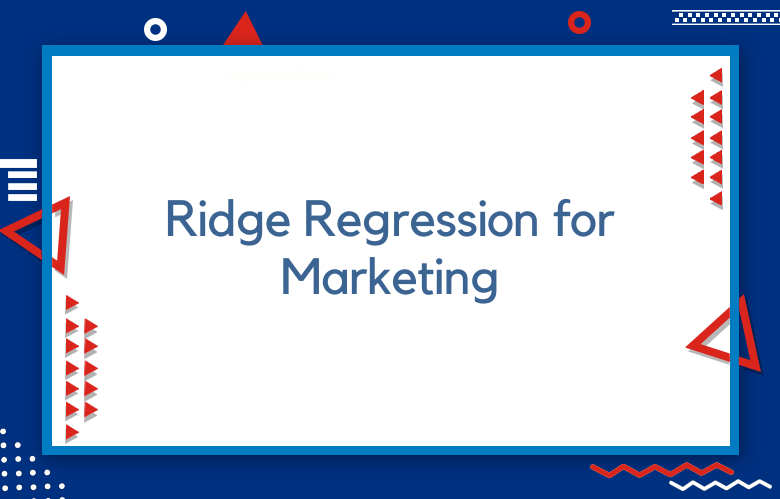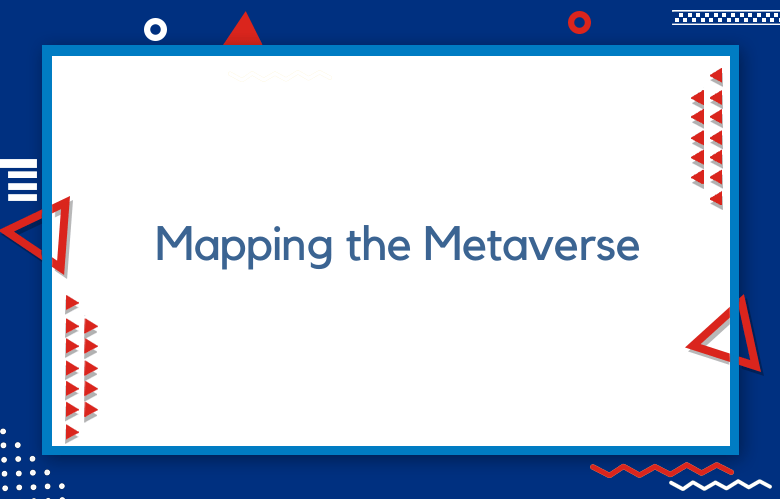Ridge Regression for Marketing using Machine Learning

Machine learning techniques have become integral to the modern business world, and marketing is no exception. With the help of machine learning, marketers can predict consumer behavior, optimize their ad campaigns, and maximize their return on investment.
One of the most powerful machine learning techniques used in marketing is Ridge Regression. In this blog post, we will explore its applications in Marketing and how it can help businesses achieve their marketing goals.
Ridge Regression is a machine learning algorithm used for regression tasks. It is beneficial when data is noisy or has many irrelevant features. In marketing, Ridge Regression can be used for various purposes, such as predicting consumer behavior, forecasting sales, and optimizing ad campaigns.
Predicting Consumer Behavior: One of the most significant applications of Ridge Regression in Marketing is predicting consumer behavior.
By analyzing consumer data such as demographics, past purchase history, and online behavior, Ridge Regression can predict what consumers will likely purchase. This information can be used to personalize marketing messages and offer targeted promotions to boost customer engagement.
What is Ridge Regression?
Ridge Regression is a popular statistical technique in machine learning and statistical modeling. It is a regularization method that can address the problem of multicollinearity, which refers to the relationship between predictor variables in a dataset.
The Ridge Regression algorithm adds a small amount of bias to the parameter estimates, thus helping to improve the stability and reliability of the model.
Ridge Regression is sometimes known as L2 regularization because it adds a penalty term based on the square of the magnitude of the coefficients (weights) associated with the predictor variables.
This penalty term is added to the traditional least squares objective function, which estimates the parameter values that minimize the sum of the squared errors between the predicted and actual outcome values.
Ridge Regression Models for Marketing
Ridge regression models have proven helpful in marketing. They enable companies to predict consumer behavior and make more effective business decisions.
One of the main advantages of ridge regression is that it can handle data with high levels of multicollinearity, often present in marketing datasets due to the vast number of variables involved.
In essence, ridge regression is a type of linear regression that adds a penalty term to the regression equation, which helps mitigate the multicollinearity issue.
This penalty term is controlled by a hyperparameter called lambda. Tuning this parameter can optimize a model by achieving the best balance between fitting the data and preventing overfitting.
Assumptions of Ridge Regressions for Marketing
Ridge regression is a widely used statistical approach in marketing primarily employed to tackle the problem of multicollinearity.
The technique is utilized when multiple linear regression variables are highly correlated, leading to issues in interpreting and predicting the results accurately. Ridge regression introduces a regularization term that restricts the model coefficients to prevent them from overfitting the data and producing unstable results.
One critical assumption of ridge regression is that the independent variables should be linearly related to the dependent variable. This means the relationship between the variables should be linear, and the model may not effectively capture non-linear relationships.
Another critical assumption is that the residuals should follow a normal distribution with a mean of zero and constant variance, indicating that the model should fit well with the data. Any deviation from these assumptions results in inaccurate predictions and unreliable results.
Understanding Ridge Regression in Marketing
Ridge regression is a popular statistical method used in marketing research to mitigate the problem of multicollinearity. Multicollinearity occurs when two or more independent variables in a regression model are highly correlated, leading to inaccurate parameter estimates and unstable prediction results.
Ridge regression addresses this issue by introducing a penalty term in the objective function that shrinks the coefficient estimates toward zero, thereby reducing their variance and increasing their stability.
One of the benefits of using ridge regression in marketing research is its ability to handle high-dimensional data sets with many interrelated variables.
By reducing the variance of the coefficient estimates, ridge regression can effectively filter out noise and identify the most relevant predictors of marketing outcomes, such as sales, customer satisfaction, and brand loyalty. This can lead to more accurate and actionable insights that inform marketing decisions and strategies.
How Ridge Regression Improves Data Analysis in Marketing
Ridge Regression, known as Tikhonov regularization, is a powerful statistical technique for marketing data analysis. It has been widely used to address the issues of multicollinearity and overfitting in regression models.
Collecting a large amount of data on various variables that may impact customer behavior is common in marketing.
However, these variables are often found to be highly correlated, which can lead to multicollinearity issues in regression models. This can make identifying the most significant predictors difficult, resulting in unstable model estimates and inaccurate predictions.
Ridge Regression addresses the problem of multicollinearity by introducing a penalty term that shrinks the coefficients of correlated variables toward zero.
By adding this penalty term, the model can identify the most critical predictors while reducing the impact of correlated variables. This results in a more stable model that is less prone to overfitting and produces more accurate predictions.
The Impact of Ridge Regression on Marketing Strategies
Ridge regression is a statistical technique widely applied in marketing research. It helps businesses optimize their marketing strategies and predicts the effects of different marketing variables on consumer behavior.
The significance of ridge regression in marketing research cannot be overstated. It has proven to be an excellent tool for optimizing the allocation of marketing resources towards campaigns that yield the highest returns.
Marketing strategies in the contemporary world require precision and accuracy. Firms invest substantial resources in targeted advertising to reach specific audiences and convince them of the value of their products or services.
However, identifying the right target audience can be challenging, and this is where ridge regression comes in. The technique enables marketers to understand the interrelationship between promotional activities, customer behavior, and business performance.
Implementing Ridge Regression for Marketing Success
Ridge Regression is a widely used technique in machine learning that has proven to be effective in the field of marketing. This approach is beneficial in situations with high levels of collinearity between the input variables, which can lead to instability in the model’s outputs.
Marketing success is crucial to the growth and sustainability of any business, and with the vast amount of data available today, Ridge Regression is an excellent tool for enhancing marketing strategies.
This method helps eliminate traditional linear regression’s drawbacks, such as overfitting and model instability, by introducing a penalty term that shrinks the coefficients toward zero, thereby reducing the impact of extraneous variables in the model.
By applying Ridge Regression to marketing campaigns, businesses can better understand their target audience and identify the most effective advertising channels.
The method helps optimize marketing strategies by analyzing the data to determine the most influential variables and adjusting campaigns accordingly.
Exploring the Benefits of Ridge Regression in Marketing
Improved Predictive Accuracy
Ridge regression is a powerful tool that can improve the predictive accuracy of marketing models.
By adding regularization terms to the model, ridge regression can help reduce overfitting and improve the model’s generalizability. This can lead to more accurate predictions, which can be used to make more informed decisions about marketing campaigns.
Reduced Variance
Ridge regression also helps to reduce variance in the model by shrinking the coefficients of less essential features.
This helps simplify the model and make it easier to interpret, which can help understand how different features impact predictions. It also helps to prevent elements with minor effects from dominating the model and skewing results.
Improved Model Interpretability
Ridge regression also improves model interpretability by providing insights into how different features impact predictions.
The regularization terms in ridge regression help identify which features are most important for making accurate predictions, which can help understand how different aspects of a campaign drive results.
Increased Stability
Ridge regression also increases a model’s stability by reducing its sensitivity to outliers or noise in the data set. This helps ensure that small changes in input data do not significantly impact predictions, making it easier to trust results and use them for decision-making purposes.
More Robust Models
Ridge regression also helps create more robust models by reducing multicollinearity between predictors in the data set. Multicollinearity occurs when two or more highly correlated predictors lead to unstable estimates and unpredictable results when making predictions with linear models such as ridge regression.
Faster Training Times
Ridge regression is also faster than other forms of linear regression, such as least squares, as it does not require an iterative process for finding optimal parameters like other forms do.
This can lead to significantly faster training times, especially when working with large datasets containing hundreds or thousands of features.
Reduced Overfitting Risk
Finally, ridge regression reduces overfitting risk by using regularization terms that penalize complex models with high levels of variance relative to their bias (error).
This helps ensure that models are not overly complex and can generalize well on unseen data points. This leads to better performance metrics on test sets than non-regularized linear models such as least squares or logistic regression.
Standardizing Variables in Ridge Regression for Marketing
In marketing research, Ridge Regression analysis is often applied to model complex relationships between predictor variables and corresponding response variables.
However, certain factors need to be considered to ensure the reliability and accuracy of Ridge Regression analysis. One such factor is the standardization of variables.
Standardizing variables refers to transforming all predictor variables to a standard scale by subtracting their mean and dividing by their standard deviation.
This ensures that all variables are on the same scale and thus can be compared fairly. Without standardization, variables with large values could dominate the analysis and overshadow the effects of other variables.
Bias and Variance Trade-off in Ridge Regression for Marketing
Ridge regression is a widely used statistical technique in marketing research to evaluate the impact of different factors on consumer behavior. It is a type of regularized linear regression that incorporates the L2-norm penalty term in the objective function to prevent overfitting and improve the model’s generalization performance.
However, one of the main challenges in ridge regression is balancing the bias-variance trade-off, which refers to the fundamental dilemma of choosing a complex model to capture the underlying patterns in the data. Still, it is not too challenging to overfit the noise.
The bias-variance trade-off in ridge regression is a crucial concept that requires an in-depth understanding of its underlying mechanisms.
A model’s bias quantifies the systematic error between the predicted and actual values, while the variance measures the variability of the predictions across different samples. In simple terms, bias reflects how much the model is underfitting the data, and variance indicates how much the model is overfitting the data.
Assumptions of Ridge Regression for Marketing Analysis
Ridge regression, also known as Tikhonov regularization, is a powerful statistical technique that has gained popularity in marketing analysis because it can handle multicollinearity issues.
Multicollinearity occurs when two or more predictor variables in a statistical model are highly correlated, making it difficult to accurately estimate the model’s coefficients. This can lead to instability in the model, incorrect parameter estimates, and poor model performance.
Ridge regression addresses the issue of multicollinearity by introducing a penalty term to the cost function that shrinks the coefficients toward zero, thus reducing their variance and improving their stability.
The penalty term, also known as the regularization parameter, is controlled by the researcher and can be adjusted to balance model complexity and predictive accuracy.
Applying Ridge Regression in a Linear Regression Problem for Marketing
Marketing plays a crucial role in business success, enabling companies to reach their target audience and calibrate their products and services accordingly.
In recent times, data-driven marketing has become increasingly popular as companies collect vast amounts of data to gain insights into customer preferences, trends, and behavior.
One of the standard data analysis methods in marketing is linear regression, which models the relationship between one dependent variable (the outcome) and one or more independent variables (predictors).
However, linear regression has limitations when dealing with large datasets with many predictors. Ridge regression, a variant of linear regression, addresses these limitations by introducing a penalty term that shrinks the regression coefficients toward zero.
This penalty term reduces the impact of multicollinearity, a common issue in marketing datasets where some variables are highly correlated. Therefore, Ridge regression can lead to more robust and accurate models, especially when dealing with high-dimensional datasets.
Regularization Techniques in Ridge Regression for Marketing Optimization
L2 Regularization
L2 regularization is one of the most commonly used techniques in ridge regression for marketing optimization. It works by adding a penalty term to the cost function that penalizes large and encourages small weights. This helps to prevent overfitting, as it reduces the complexity of the model and forces it to generalize better.
Early Stopping
Early stopping is another technique used in ridge regression for marketing optimization. This technique works by monitoring the validation error during training and stopping training when the validation error begins to increase. This helps to reduce overfitting, as it prevents the model from continuing to fit the training data too closely.
Weight Decay
Weight decay is another technique used in ridge regression for marketing optimization. This technique encourages smaller weights by adding a penalty term to the cost function that penalizes large weights and encourages small weights. This helps prevent overfitting, reduces complexity, and forces the model to generalize better.
Dropout
Dropout is a technique used in deep learning networks that can also be applied to ridge regression for marketing optimization. The idea behind dropout is that some neurons are randomly “dropped out” during each iteration of training, which helps to reduce overfitting by preventing complex patterns from forming within the network.
Data Augmentation
Data augmentation is a machine learning technique in which additional data points are generated from existing data points using various transformations, such as scaling, rotation, etc.
This technique can be applied to ridge regression for marketing optimization by creating new data points containing more information about customer behavior or preferences than existing data points, which can help improve predictive accuracy and reduce overfitting.
Feature Selection
Feature selection is another technique used in ridge regression for marketing optimization, which involves selecting only the features most important for predicting customer behavior or preferences rather than using all available features indiscriminately.
Setting only the most relevant features helps reduce complexity and prevent overfitting because irrelevant features are included unnecessarily in the model.
Ensembling
Ensembling is a technique where multiple models are combined into one model, which has higher predictive accuracy than any individual model alone. In ridge regression for marketing optimization, this could involve combining multiple models trained on different subsets of customer data or different feature sets into one larger model with improved predictive accuracy.
Regularization Parameter Tuning
Regularization parameter tuning is an essential step in ridge regression for marketing optimization. It involves finding an optimal value of lambda (the regularization parameter) that minimizes bias and variance without causing under- or overfitting.
Tuning this parameter appropriately ensures that our model performs well on unseen test data and future incoming customer data.
Conclusion
In this blog post, we have explored Ridge Regression and its applications in Marketing. Ridge Regression can help marketers predict consumer behavior, forecast sales, and optimize ad campaigns, maximizing their return on investment.
With machine learning’s growing importance in the business world, mastering Ridge Regression has become crucial for marketers who want to stay ahead of the competition. By leveraging this robust algorithm, businesses can gain a significant advantage in the highly competitive marketing landscape.
In conclusion, machine learning techniques such as ridge regression have shown great promise in helping companies achieve their marketing goals. Companies can unlock their full potential in the market by analyzing data, predicting consumer behavior, and building effective campaigns.
While ridge regression has limitations, it can significantly improve marketing strategies when applied correctly. As the marketing landscape continues to evolve, so should our approach to analysis and predictions, and machine learning techniques such as ridge regression will play a critical role in that evolution.
Call: +91 9848321284
Email: [email protected]



